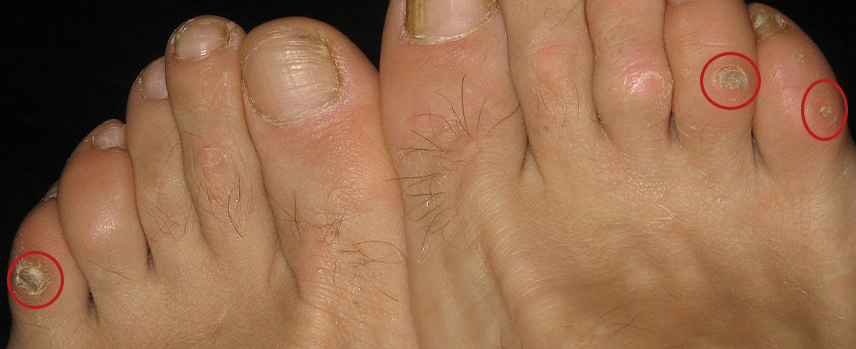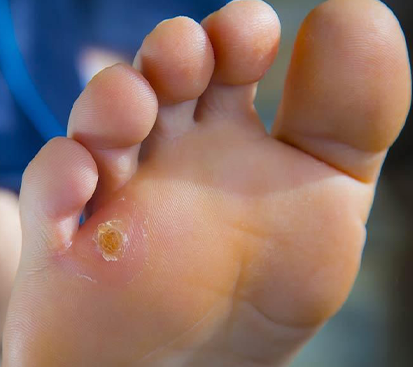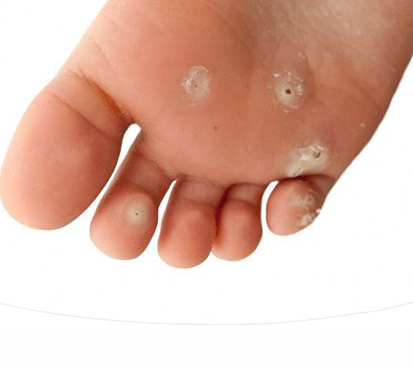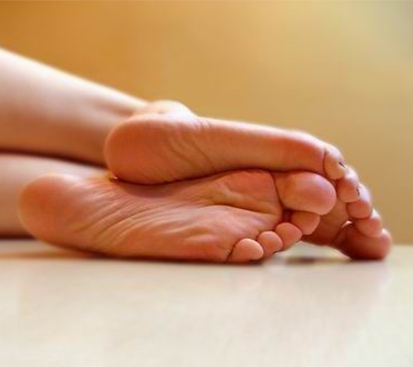
Corns are thickened and hardened areas of skin that typically develop in response to repeated pressure or friction. They commonly appear on the toes, soles, or other bony areas of the feet. Corns form as a protective response to excessive stress on the skin, but they can become painful and uncomfortable if left untreated. These hardened layers often result from various factors, such as wearing tight or ill-fitting footwear, prolonged standing, or structural foot deformities like bunions or hammertoes. Corns may initially appear as small, rough patches, but they can worsen over time, causing discomfort when walking or wearing shoes.
While mild corns may improve with home remedies such as soaking the feet, using pumice stones, or applying moisturizing creams, persistent or painful corns may require professional medical attention for effective relief. Without proper care, corns can continue to thicken, increasing the risk of discomfort, inflammation, or even infection.At our specialized corn foot treatment clinic in Kolathur and corn foot treatment hospital in Mogappair, we provide comprehensive care solutions tailored to manage corns effectively. Our experienced specialists carefully assess the severity of your condition before recommending suitable treatment options. From conservative treatments such as medicated patches and corn pads to advanced procedures like corn excision or debridement, we create customized treatment plans to ensure lasting relief and improved foot comfort. Our clinic is equipped with modern diagnostic tools and advanced treatment techniques to deliver precise care that addresses the root cause of your corn condition.
Seeking timely intervention at our corn foot treatment hospital in Kolathur or corn foot treatment clinic in Mogappair is essential to prevent complications and ensure a smoother recovery. Our dedicated specialists focus not only on effective treatment but also on preventive care strategies. We guide patients on proper foot hygiene, footwear choices, and lifestyle adjustments to reduce pressure points and minimize the risk of corns recurring. By addressing both treatment and prevention, we help you achieve long-term relief and improved foot comfort.
Recognizing the symptoms of a corn early is crucial to preventing further discomfort and potential complications. Corns typically begin as small, hardened patches of skin that may feel rough or dry. As they develop, they can become increasingly tender, especially when pressure is applied. Common signs include a raised, thickened area of skin, pain or discomfort when walking, and redness or inflammation around the affected area. Identifying these early warning signs allows for timely intervention, helping to ease discomfort and prevent the corn from worsening.

If you notice any of these symptoms, seeking help from a corn foot specialist in Kolathur or corn foot treatment clinic in Mogappair can prevent the condition from worsening. Our specialists provide customized treatment options to ensure effective relief.
Surgical intervention is considered when corns become deeply embedded, cause severe pain, or show signs of infection that do not respond to standard treatments. In such cases, our experienced specialists at the corn foot treatment clinic in Kolathur and corn foot treatment hospital in Mogappair perform precise surgical procedures to eliminate stubborn corns effectively. The surgery typically involves carefully removing the thickened skin layers or correcting underlying structural issues that contribute to corn formation.


Our skilled corn foot surgeons in Kolathur and corn foot specialists in Mogappair carefully assess each case to determine the most suitable surgical approach, ensuring effective recovery and long-term relief.
Accurate diagnosis is crucial in determining the best approach to manage corns effectively. At our specialized corn foot treatment hospital in Kolathur and corn foot clinic in Mogappair, we utilize advanced diagnostic techniques to assess the size, depth, and underlying causes of corns. Our skilled specialists may conduct a thorough foot examination, assess your gait, and evaluate pressure points that contribute to corn formation. In some cases, imaging tests may be recommended to detect bone abnormalities or structural issues. By identifying the root cause, we create personalized treatment plans that ensure effective relief and reduce the risk of recurrence.
- Physical Examination – To evaluate the size, location, and severity of the corn.
- X-rays – Recommended if a foot deformity is contributing to the corn's development.
- Pressure Analysis – Used to identify abnormal pressure points on the foot.

Following diagnosis, our specialists provide effective treatments such as medicated patches, corn pads, orthotic devices, or surgical intervention for severe cases. With our comprehensive approach, we ensure long-term comfort and improved foot health.